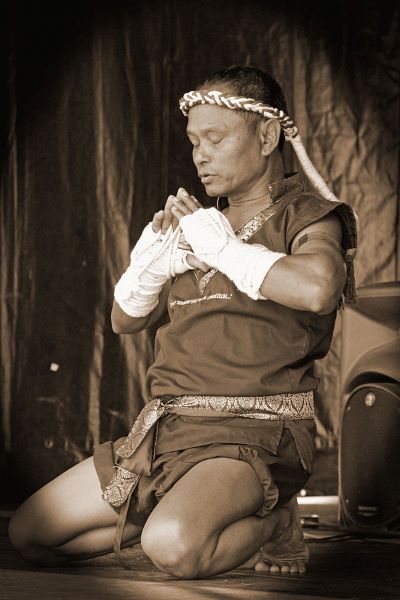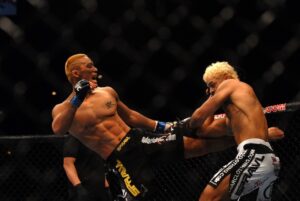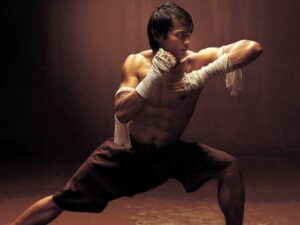
Are you wondering what Muay Thai ropes are?
In this article, we’ll examine what Muay Thai ropes are, what Kard Chuek is, why Muay Thai fighters wear ropes and the different Kard Chuek wrapping styles.
Contents
What Are Muay Thai Ropes?
Muay Thai ropes are hemp ropes used to wrap a fighter’s hands and wrists to protect them from breaks and strains by providing support when punching. Muay Thai ropes are typically ¼ inch (0.6 cm) in diameter and fighters use around 15 meters of rope to wrap each hand.
The official name of Muay Thai ropes is Kard Chuek. Translated, Kard Chuek means ‘tie a rope’, and Muay Kard Chuek means rope-bound boxing.
Rather than Mauy Thai, it was Muay Boran fighters who wore Kard Chuek, worn to inflict more damage on their opponent and to protect their hands and wrist when fighting. Muay Boran translates to ancient boxing and is the umbrella term for all fighting styles born in Thailand.
How the hand is wrapped depends on the substyle of Muay Boran, which is differentiated by the style of fighting and the location of birth in Thailand. For example, Muay Thasao (southern Thailand) is a kicking-heavy style so they wrap their whole forearm to help block kicks.
Muay Thai fighters don’t use hemp ropes to wrap their hands, instead, they use Muay Thai hand wraps made from gauze and tape such as the ones also used in MMA and boxing. This is because Muay Thai fighters have to wear 8 to 10-oz gloves, and hemp rope would feel uncomfortable and be hard to fit underneath.
What Is Kard Chuek?
Translated, Kard Chuek means to tie a rope, and Muay Kard Chuek means rope-bound boxing. Kard Chuek is more commonly called Muay Thai ropes, simply because people don’t know their official Thai name.
It’s unknown when Kard Chuek was first used by Muay Boran fighters, but as Muay Thai had become increasingly popular as entertainment in the early 18th century (the 1720s), it’s likely to have been first used around this time.
This means Muay Thai ropes (Kard Chuek) were used by Muay Boran fighters for roughly 200 years before Muay Thai was modernized into a combat sport with rules and regulations in the late 1920s and early 1930s.
This included rules such as weight classes, rounds, time limits, governing bodies, associations, and of course, Muay Thai gloves in order to reduce impact and cuts.
The motive to introduce rules and especially gloves came after the death of a Cambodian Khmer fighter in 1928 at the hands of a Thai boxer known as Phae Lieng Prasert. As a result, the Thai Ministry of Interior banned the use of Kard Chuek in 1928 and Muay Thai gloves became mandatory.
In modern times, Muay Thai fighters wrap their hands with cloth and gauze (like boxers and MMA fighters) underneath their gloves as a way to further protect their hands and wrists through increased stability and compactness.
In 2013, Kard Chuek made a return when Thai Fight (ไทยไฟต์ = Taii Fai) reintroduced Muay Kard Chuek with a slight twist to make it legal.
Their Muay Kard Chuek fighters have to wear thin padding in the shape of a glove underneath the Kard Chuek, or 4-oz MMA gloves which are used by Muay Thai fighters in ONE Championship.
The Kard Chuek isn’t allowed to have knots and the rope is made from cotton as it’s much less coarse than the formerly used hemp rope. The Kard Chuek is finally taped over to keep the ropes in place.
Essentially, the Kard Chuek is just for show and a way to keep the centuries-old Kard Chuek tradition alive, as they simply act as increased stability when punching much like the modern Muay Thai wraps which go underneath the gloves.
The Kard Chuek fights promoted by Thai Fight are also under Muay Thai rules.
Here’s a video showing how Kard Chuek is wrapped in modern times.
Why Do Muay Thai Fighters Wear Ropes?
As mentioned, Muay thai ropes were worn by Muay Boran fighters, more specifically, Muay Kard Chuek fighters.
Muay Thai ropes were worn because they differentiated Muay Boran from European bare-knuckle boxing and they made fights more entertaining.
Muay Thai ropes protected the fighter’s hands and wrists from breaks and strains by providing support when punching.
Much like Muay Thai hand wraps, they help keep the bones and joints fastened together to avoid them moving independently in different directions, as well as creating a more evenly distributed impact across the hand and wrist.
This meant Muay Boran fighters could punch harder for more extended periods of time because they were less likely to get injured – ultimately making fights more entertaining for spectators.
Muay Thai ropes were also worn by Muay Boran fighters because they were more likely to cut an opponent and make them bleed.
They used rough hemp rope and also tied knots on the knuckle to act as knuckle dusters for increased damage. The knots were called Gon Hoi (ก้นหอย: Gon Hooi) meaning spiral shells, which were also frequently tied on the back of the hand in Muay Chaiya for more damaging back fist techniques.
The Kard Chuek were wrapped tighter to increase impact and damage, and they were sometimes further hardened by wetting the rope and drying it in the sun before fighting.
Muay Thai fighters also wore ropes because they were effective for blocking – at least more effective than bare knuckles. The sides of the Kard Chuek were plaited for blocking and deflecting kicks, punches, and elbows, similar to how leg checks work by offering a hard shin for the opponent to hit and injure themself.
This string of rope down the sides was known as Khaeng Sing, meaning Lion Shin, and it was also effective for more damaging strikes.
There’s a myth that Muay Boran fighters would dip their Kard Chuek in resin and glass before fighting to make it more brutal. However, there isn’t a reputable source supporting this.
There may have been the odd unregulated fight where this happened during the 18th century or before, but it wouldn’t have been a regular occurrence.
The myth of Muay Thai ropes being dipped in glass was perpetuated by the final scene in the Kickboxer movie, which featured an underground Kard Chuek/Muay Boran fight.
Overall, Muay Boran fighters (Kard Chuek) wore ropes to increase protection and support of their hands and wrist so they could punch harder for longer, and to inflict further damage and cuts on their opponent.
This was essentially what the audience of Muay Boran fights wanted, and it was a way to differentiate Muay Boran (ancient boxing) from European bare-knuckle boxing.
What Are the Different Kard Chuek Wrapping Styles?
As mentioned above, there are different substyles of Muay Boran which wrap Kard Chuek slightly differently. The four main substyles of Muay Boran wrap Kard Chuek the following way.
Muay Chaiya – named after the southern district of Chaiya, Muay Chaiya emphasizes defense via blocking and has an extensive wrestling and ground fighting system.
While Muay Chaiya emphasizes blocking, it’s the most balanced style so they wrap their Kard Chuek only around the hands up to the wrist so they have a great range of motion for grappling and can more easily strike with the forearm/elbow.
Muay Lopburi – named after the central province of Lopburi, Muay Lopburi is an aggressive style and emphasizes uppercuts, fast footwork, unpredictability, and jumping attacks.
Muay Lopburi wraps their Kard Chuek from the hand to halfway up the forearm so they can block aggressive strikes while still using the elbow to slice their opponent.
Muay Korat – named after the eastern city of Khorat, Muay Korat emphasizes wide powerful punching and kicks, front kicks, and five variations of headbutts.
Muay Korat is one of the more aggressive styles, so for effective blocking, the Kard Chuek’s wrapped up to the middle of the forearm and sometimes to the elbow, depending on personal preference.
Muay Thasao – named after the subdistrict of Tha Sao in northern Thailand, Muay Thasao emphasizes speed (especially with kicks), aggression, and defeating an opponent as quickly and efficiently as possible.
As Muay Thasao is a kicking-heavy style most similar to Muay Thai, the Kard Chuek’s wrapped from the hand to the elbow, covering the whole forearm for effectively blocking kicks.
Overall – while each substyle of Muay Boran had its own distinct way of wrapping Kard Chuek, there were many fighters who went against the norm depending on their personal wrapping preference due to how they fought.
Overall
So, ‘What are Muay Thai ropes?’
Muay Thai ropes, officially called Kard Chuek (tie a rope), are hemp ropes used to wrap a Muay Boran fighter’s hand, wrist, and sometimes forearm to protect the hands from breaks and strains and to support the wrist when punching.
Muay Boran fighters typically wear Kard Chuek which is ¼ inch in diameter and around 15 meters in length for each hand.
The purpose of the Kard Chuek was to give fighters better protection which would allow them to punch harder for longer during a fight. They were also worn because they were rough and more likely to cut an opponent and make them bleed, as well as being useful for blocking strikes.
Essentially, Muay Thai ropes (Kard Chuek) were worn because they made Muay Boran fights more entertaining for spectators, and it was a way to differentiate Muay Boran from bare-knuckle boxing in England.




